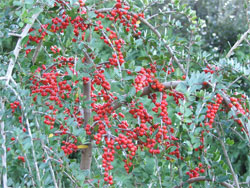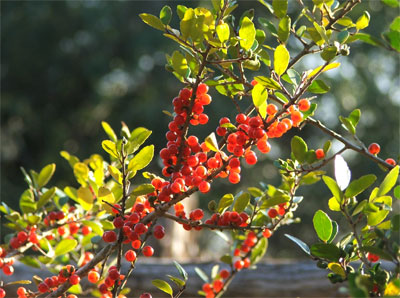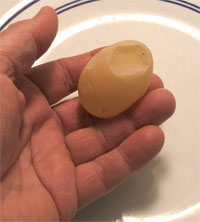Native Son – January, 2010

Toby Mize overlooks a landscape filled with mature yaupons at the Fort Worth Botanic Garden. All photos by Steven Chamblee.
Yaupons and Eggs
Woke up, coffeed up, packed up, and headed out this morning. Surprise! The white truck I parked under that live oak tree last night is now polka-dot, and it isn’t pretty. By the time I release the chickens from the hen house to free-range, my mind has warped enough to think of it as art … maybe I could drive into Fort Worth, park it out front of the Modern Art Museum with a label stuck on the windshield: “Warhol Strikes Again!!!” Maybe to the Museum of Science and History: “Nature and Man: Co-existing in Harmony.” Maybe just the car wash….
While the culprits are long gone, they left lots of evidence. Ever the scientist, I examine it closely and hypothesize it is either processed mistletoe or yaupon holly fruit. Both fruits are poisonous to people, but relished by birds. The birds … I’ve been seeing lots of dove lately, but they don’t usually group themselves close enough to do this kind of decorating. Grackles come and go, but I haven’t noticed any lately. Hmmm, perhaps I should go to work now.

Weeping yaupon.
As I stride into the Silver Garden at Chandor Gardens, my attention is immediately drawn to a fiesta at the far end. Getting closer, I see it is not just a party, but a banquet. Ahhh, the culprits … and they’re busy reloading. Dozens of cedar waxwings are busy devouring the fruits from the garden’s block of yaupon hollies. Yaupon holly (Ilex vomitoria) is one of the most popular landscape plants in North Central Texas, but it’s actually not native here; rather, it’s indigenous in acidic soils north, south and east to Oklahoma, Mexico and the Atlantic. Yaupon is a small, multi-trunked tree that matures to about 18 feet, though I’ve seen a few specimens half again as tall as that. The small, evergreen leaves do indeed contain caffeine, and were used as a tea by both Native Americans and settlers up to the early 20th century. The other side of the coin is that many Native American tribes used yaupon to incite … oh, how to put it politely? … exuberant regurgitation; hence, that lovely specific epithet in the botanical name. They brewed the leaves into a very strong, scalding hot “black drink” specifically for ceremonial intoxication and subsequent public purging. A purge party… how quaint. Thankfully, these days this practice is restricted primarily to college students.

Yaupon fruit, undiscovered by birds.

Standard yaupon,
AKA Mr. Happy.

The flexible shell
of a soft egg.
Anywhoo, yaupons are prized for their graceful growth habit, beautiful bright red berries, and the ability to withstand almost all of the punishment Texas gardeners can throw at them. (This includes underwatering/overwatering, poodling/pollarding, full sun/full shade, sandy/heavy clay/rocky/compacted soils … and it goes on forever.) Yaupon proudly stands as one of the few plants that survive anything but bulldozers.
Arriving home this afternoon, I get another surprise. One of my chickens has laid a “soft egg” in the nestbox. I’m sure there’s a 15-syllable term floating around out there in Poultryworld for such an event, but I’m quite happy with “soft egg.” A fairly rare happening, I would guess, since this is only the second soft egg I’ve seen in my six years as a chicken rancher. A soft egg is an egg that is laid a day or so earlier than normal, so the shell lacks hardness and is quite pliable. At first it seems wildly bizarre, but when you think about it, many eggs are normally this way — lizards, turtles, snakes come to mind — yet their eggs are all termed “leathery,” which does not describe the chicken’s soft egg at all. The best I can do is “like a small, water-filled plastic bag that has been painted with glue and rolled in fine sand.”
Inside the egg, all seems normal — almost clear, viscous albumen and a nice mounded yellow yolk. Ah yes, a potential chick and the fuel necessary to power the transformation into such. A seed is pretty much the same thing, of course — a future plant and the fuel necessary to take it from “nothing” to seedling. “Nothing???” Well, hardly. The BRIT book* defines a seed as “a fertilized ripened ovule, covered by a seed coat and containing the embryo, and in flowering plants, the endosperm….” It goes on to mention other things, but that’s the gist of it. The big difference between these two “life capsules” is that a plant ovule won’t form a seed without fertilization, but a hen will lay her egg, fertilized or not. Well, that, and chickens have feet.
So I’m carrying today’s eggs back past my truck when my spotted hen, Dotty, comes around the fender and stops dead in her tracks, looking kind of guilty. I ask her kindly, “Was that you who pooped on my truck?”
Right on cue, Dotty evacuates and struts off, leaving a substantial pile of evidence. In chicken language, that means, “If I did it, you’d know it.”
FOOTNOTE:
* Shinner and Mahler’s Manual to the Vascular Plants of North Central Texas by The Botanical Research Institute of Texas.
About the author: Steven Chamblee is the chief horticulturist for Chandor Gardens in Weatherford and a regular contributor to Neil Sperry’s GARDENS magazine and e-gardens newsletter. Steven adds these invitations:
While Chandor Gardens is officially closed during the winter months, lots of visitors still enjoy the garden during "the bones season." Just give us a call before you come out to make sure we’re here: 817-613-1700 or 817-598-4029.
A little help from my friends…. I still need some destinations for my Texas road trips! If you would like me to speak to your garden club or group, just shoot me an e-mail at schamblee@weatherfordtx.gov to make arrangements. I’m inexpensive and low maintenance, and you know I love to go just about anywhere, so let me know. No city too big; no town too small. As long as it has a Farm to Market road nearby, I’m in.

